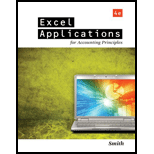
Concept explainers
- a. Reset the Data Section to its initial values. The price of this bond is $1,407,831. What would it be if there were only 9 or 8 years to maturity? Use the worksheet to compute the bond issue prices and enter them in the spaces provided.
Bond issue price (9 years to maturity) $__________________
Bond issue price (8 years to maturity) $__________________
- b. Compare these prices to the bond-carrying values found in the effective interest amortization schedule you originally printed out in requirement 3. Explain the similarity.
- c. Click the Chart sheet tab. The chart presented shows the price behavior of this bond based on years to maturity. Explain what effect years to maturity has on
bond prices. Check your explanation by trying 8% as the effective rate (cell E10) and clicking the Chart sheet tab again. Also try 9%.
When the assignment is complete, close the file without saving it again.
Worksheet. Modify the BONDS3 worksheet to accommodate bonds with up to 20-year maturity. Use your new model to determine the issue price and amortization schedules of a $2,000,000, 18-year, 10% bond issued to yield 9%. Preview the printout to make sure that the worksheet will print neatly, and then print the worksheet. Save the completed file as BONDST.
Hint: Expand both amortization schedules to 20 years. Expand the scratch pad to 20 years. Modify FORMULA1 in cell F17 to include the new ranges.
Chart. Using the BONDS3 file, prepare a line chart that plots annual interest expense over the 10-year life of this bond under both the straight-line and effective interest methods. No Chart Data Table is needed. Put A23 to A32 in the Label format and then select A23 to A32, D23 to D32, and B40 to B49 as a collection. Enter all appropriate titles, legends, formats, and so forth. Enter your name somewhere on the chart. Save the file again as BONDS3. Print the chart.
Trending nowThis is a popular solution!

Chapter 11 Solutions
Excel Applications for Accounting Principles
 Excel Applications for Accounting PrinciplesAccountingISBN:9781111581565Author:Gaylord N. SmithPublisher:Cengage Learning
Excel Applications for Accounting PrinciplesAccountingISBN:9781111581565Author:Gaylord N. SmithPublisher:Cengage Learning Pfin (with Mindtap, 1 Term Printed Access Card) (...FinanceISBN:9780357033609Author:Randall Billingsley, Lawrence J. Gitman, Michael D. JoehnkPublisher:Cengage Learning
Pfin (with Mindtap, 1 Term Printed Access Card) (...FinanceISBN:9780357033609Author:Randall Billingsley, Lawrence J. Gitman, Michael D. JoehnkPublisher:Cengage Learning EBK CONTEMPORARY FINANCIAL MANAGEMENTFinanceISBN:9781337514835Author:MOYERPublisher:CENGAGE LEARNING - CONSIGNMENT
EBK CONTEMPORARY FINANCIAL MANAGEMENTFinanceISBN:9781337514835Author:MOYERPublisher:CENGAGE LEARNING - CONSIGNMENT


